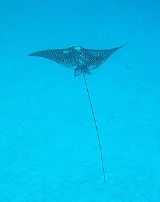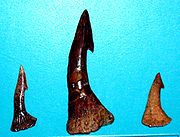
Rajiformes
Encyclopedia
Rajiformes is one of the four orders
of batoids
, flattened cartilaginous fishes related to shark
s.
Rajiforms are distinguished by the presence of greatly enlarged pectoral fins, which reach as far forward as the sides of the head, with a generally flattened body. The undulatory pectoral fin motion diagnostic to this taxon is known as rajiform
locomotion. The eyes and spiracle
s are located on the upper surface of the body, and the gill slits on the underside. They have flattened, crushing teeth, and are generally carnivorous, although manta ray
s are filter feeders. Most species give birth to live young, although some lay eggs with a horny capsule ("mermaid's purse
").
 The following families are recognized:
The following families are recognized:
A fossil family is Rhombodontidae, from the Maastrichtian
stage of the Cretaceous
period of Europe, Asia, Africa and the Americas.
Order (biology)
In scientific classification used in biology, the order is# a taxonomic rank used in the classification of organisms. Other well-known ranks are life, domain, kingdom, phylum, class, family, genus, and species, with order fitting in between class and family...
of batoids
Batoidea
Batoidea is a superorder of cartilaginous fish commonly known as rays and skates, containing more than 500 described species in thirteen families...
, flattened cartilaginous fishes related to shark
Shark
Sharks are a type of fish with a full cartilaginous skeleton and a highly streamlined body. The earliest known sharks date from more than 420 million years ago....
s.
Rajiforms are distinguished by the presence of greatly enlarged pectoral fins, which reach as far forward as the sides of the head, with a generally flattened body. The undulatory pectoral fin motion diagnostic to this taxon is known as rajiform
Rajiform
Rajiform swimming is a type of aquatic locomotion practiced by some fishes such as skates and rays that makes use of undulatory pectoral fin motion....
locomotion. The eyes and spiracle
Spiracle
Spiracles are openings on the surface of some animals that usually lead to respiratory systems.-Vertebrates:The spiracle is a small hole behind each eye that opens to the mouth in some fishes. In the primitive jawless fish the first gill opening immediately behind the mouth is essentially similar...
s are located on the upper surface of the body, and the gill slits on the underside. They have flattened, crushing teeth, and are generally carnivorous, although manta ray
Manta ray
The manta ray is the largest species of the rays. The largest known specimen was more than across, with a weight of about . It ranges throughout waters of the world, typically around coral reefs...
s are filter feeders. Most species give birth to live young, although some lay eggs with a horny capsule ("mermaid's purse
Mermaid's purse
An egg case or egg capsule, colloquially known as a mermaid's purse or devil's purse, is a casing that surrounds the fertilized eggs of some sharks, skates, and chimaeras. They are among the common objects which are washed up by the sea. They are made of collagen protein strands...
").
Classification

- Family Anacanthobatidae (smooth skates)
- Family Rajidae (skates)
- Family Rhinidae (bowmouth guitarfishes)
- Family Rhinobatidae (guitarfishes)
- Family Rhynchobatidae (wedgefishes)
A fossil family is Rhombodontidae, from the Maastrichtian
Maastrichtian
The Maastrichtian is, in the ICS' geologic timescale, the latest age or upper stage of the Late Cretaceous epoch or Upper Cretaceous series, the Cretaceous period or system, and of the Mesozoic era or erathem. It spanned from 70.6 ± 0.6 Ma to 65.5 ± 0.3 Ma...
stage of the Cretaceous
Cretaceous
The Cretaceous , derived from the Latin "creta" , usually abbreviated K for its German translation Kreide , is a geologic period and system from circa to million years ago. In the geologic timescale, the Cretaceous follows the Jurassic period and is followed by the Paleogene period of the...
period of Europe, Asia, Africa and the Americas.

